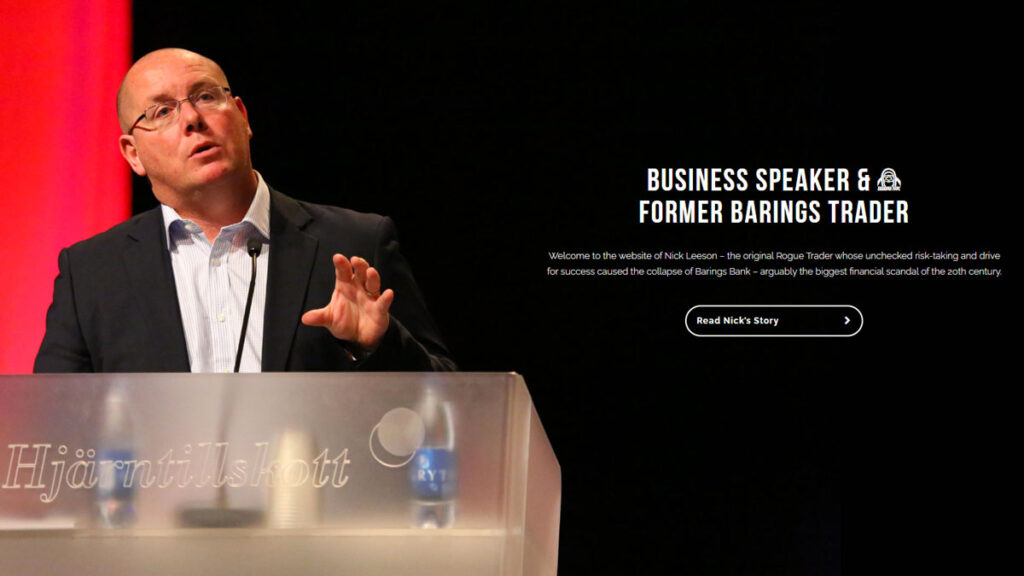Nick Leeson – Rogue Trader

Nick Leeson: The Fall of Barings Bank
Nick Leeson was a derivatives broker who gained notoriety in the mid-1990s for his role in the collapse of Barings Bank. At the time, Barings was one of the oldest and most respected financial institutions in the United Kingdom, with a history dating back to the 18th century. The bank had established a reputation for excellence in a variety of financial services, including corporate finance, asset management, and securities trading.
Leeson was hired by Barings in 1989 as a clerk in the bank’s back office operations in London. Over the next few years, he worked his way up the ranks, eventually being sent to the bank’s newly established office in Singapore in 1992. Leeson was put in charge of trading futures and options on the Singapore International Monetary Exchange (SIMEX), which was a fast-growing market at the time.
Leeson’s initial performance was impressive, and he quickly made a name for himself as a skilled trader. He was particularly successful in trading futures contracts on the Nikkei 225, which is the benchmark index of the Tokyo Stock Exchange. However, Leeson was also under intense pressure to deliver profits, and he soon began taking increasingly risky positions in the market.
One of Leeson’s most significant trades was a massive position he took in the Japanese stock market in 1994. He was betting that the market would recover from a slump caused by an earthquake that had hit the city of Kobe earlier that year. However, the market continued to fall, and Leeson found himself losing large sums of money. He then made a fateful decision to start making unauthorized trades to cover up his losses.
Leeson’s unauthorized trades involved creating fictitious accounts, which he used to hide his losses from his superiors at Barings. He claimed that these accounts were used to process trades for clients who preferred to remain anonymous. However, in reality, these accounts were purely fictitious and were used to cover up Leeson’s mounting losses.
Leeson’s downfall began in early 1995 when SIMEX began investigating his trading activities. They found evidence of irregularities in his accounts and raised concerns with Barings management. However, Barings executives did not take the matter seriously and failed to investigate further. They believed that Leeson was simply a skilled trader who was making money for the bank, and they did not want to interfere with his activities.
In February 1995, Leeson’s losses became so severe that they could no longer be concealed. Barings was facing bankruptcy, with estimated losses of around £827 million ($1.3 billion). The bank was eventually sold to ING Group, a Dutch financial institution, for just £1.
Leeson fled to Malaysia, but was eventually arrested in Frankfurt, Germany, and extradited to Singapore to stand trial. He was charged with forgery and cheating, which are criminal offenses in Singapore, and was sentenced to six and a half years in jail.
Lessons Learned from the Barings Collapse
The collapse of Barings Bank was a major shock to the financial world, and it led to widespread scrutiny of the banking industry. The case exposed significant flaws in Barings’ internal controls, risk management, and corporate governance. It also raised questions about the effectiveness of regulatory oversight in the financial sector.
There were several lessons that the banking industry and regulators learned from the Barings collapse. Some of the most significant lessons include:
The importance of effective risk management: The collapse of Barings Bank highlighted the critical role of risk management in the banking industry. Banks must have effective systems in place to identify, measure, and manage risk. They must also have appropriate internal controls to prevent unauthorized trading activities.
The need for corporate governance: The Barings collapse highlighted the importance of good corporate governance. Banks need to have strong leadership, effective oversight, and a culture of ethical behavior. They must also ensure that their internal controls and risk management systems are adequate.
The importance of whistleblowing: The Barings case also highlighted the need for effective whistleblowing mechanisms. Employees should be encouraged to report any suspicious behavior or unauthorized activities, and banks should have a system in place to investigate such reports.
The role of regulators: The Barings case raised questions about the effectiveness of regulatory oversight in the banking industry. Regulators need to ensure that banks are following sound risk management practices and that their internal controls are adequate. They must also have the authority to take action when necessary to prevent systemic risks.
The consequences of rogue trading: The Barings case demonstrated the severe consequences of rogue trading. Banks need to ensure that they have appropriate controls and oversight in place to prevent unauthorized trading activities. They must also have a clear understanding of the risks associated with their trading activities.
Nick Leeson’s Legacy
Nick Leeson’s actions had a significant impact on the banking industry, and his name has become synonymous with rogue trading. His story has been the subject of several books, documentaries, and even a Hollywood film. However, Leeson has also used his experiences to educate others about the risks of unethical behavior in the banking industry.
Since his release from prison in 1999, Leeson has worked as a public speaker, sharing his story and the lessons he learned from the Barings collapse. He has also written several books, including “Rogue Trader: How I Brought Down Barings Bank and Shook the Financial World,” which provides a detailed account of his experiences.
Leeson’s story serves as a cautionary tale for the banking industry, and his experiences have helped to raise awareness of the importance of effective risk management, corporate governance, and ethical behavior. His legacy is a reminder that the actions of a single individual can have far-reaching consequences, and that banks must be vigilant in preventing unauthorized trading activities and other unethical behavior.
Conclusion
Nick Leeson’s actions in the mid-1990s had a significant impact on the banking industry, and his story serves as a reminder of the risks associated with unethical behavior. The collapse of Barings Bank highlighted the importance of effective risk management, corporate governance, and regulatory oversight in the banking industry. Banks must be vigilant in preventing rogue trading activities and other unethical behavior, and they must ensure that their internal controls and risk management systems are adequate. Nick Leeson’s legacy is a cautionary tale for the banking industry, and his experiences have helped to raise awareness of the importance of ethical behavior in the financial sector.
Frequently Asked Questions about Nick Leeson.
Nick Leeson lost a significant amount of money by taking increasingly risky positions in the derivatives market. In 1994, he made a massive bet on the Japanese stock market, speculating that it would recover from a slump caused by an earthquake that had hit the city of Kobe earlier that year. However, the market continued to fall, and Leeson found himself losing large sums of money.
Rather than admitting his losses to his superiors at Barings, Leeson began making unauthorized trades to cover up his losses. He created fictitious accounts, which he used to hide his losses from his bosses. He claimed that these accounts were used to process trades for clients who preferred to remain anonymous. However, in reality, these accounts were purely fictitious and were used to cover up Leeson’s mounting losses.
Leeson’s unauthorized trades involved taking large positions in the market without proper risk management controls in place. He engaged in a technique called “doubling down,” where he would double his bets in the hope of recouping his losses. However, this strategy only compounded his losses further, and he found himself in a situation where he had no way of covering his mounting debts.
Leeson’s actions eventually led to the collapse of Barings Bank, which had to be sold to ING Group for just £1. The bank’s losses were estimated at around £827 million ($1.3 billion), with Leeson’s unauthorized trades responsible for a significant portion of the losses.
In summary, Nick Leeson lost so much money by taking increasingly risky positions in the derivatives market, making unauthorized trades, and covering up his losses with fictitious accounts. His actions had severe consequences, leading to the collapse of Barings Bank and significant losses for the bank’s clients and investors.
Leeson initially set up account 88888 as a back-office account to correct errors that occurred in his trading activities. The account was intended to be a temporary measure to correct mistakes made in trading activities, such as errors in the settlement of trades.
In the early days of trading, Leeson used the account for legitimate purposes, such as to process trades that had been incorrectly booked. However, as his trading losses mounted, he began using the account to hide the losses and conceal unauthorized trades from his superiors at Barings Bank.
Leeson used account 88888 to cover up losses from his trades by booking false profits into the account, thereby hiding his mounting losses from the bank’s management. He would then transfer the profits to other accounts, which made his trading activities appear profitable to his superiors. However, in reality, the profits were entirely fictitious and were used to cover up losses that he had incurred in unauthorized trades.
The use of account 88888 was one of the key factors that contributed to the collapse of Barings Bank. The account allowed Leeson to hide his losses from his superiors, which prevented the bank from taking appropriate action to correct the situation before it spiraled out of control.
In summary, Leeson initially set up account 88888 as a back-office account to correct errors in his trading activities. However, as his losses mounted, he began using the account to conceal unauthorized trades and cover up his losses. The use of account 88888 played a significant role in the collapse of Barings Bank.
An Interview with Nick Leeson.
Additional Resources for Nick Leeson.
Nick Leeson’s Website
Trade with Nick Leeson
Articles by Nick Leeson





Responses